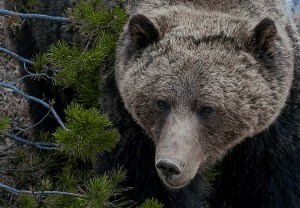
Grizzly research beginning in and around JNP
Jasper National Park and the Foothills Research Institute will work together this summer to estimate the grizzly bear population in and adjacent to certain areas of Jasper National Park.
Researchers will collect hair samples from bear rub trees by selecting specific trees and covering them with barbed wire, and setting up scent lure sites nearby with a special smell to attract the bears.
Hair follicles will be collected from these bear rub trees. DNA from the hair follicles will be used to help identify individuals and calculate bear population.
The project will include areas south of Highway 16 in Jasper National Park and in the province of Alberta adjacent to the park. Similar research was completed in northern sections of Jasper National Park in 2008.
Additional information for trail users: The bear rub trees will be along trails, with scent lure stations at least 200 metres away from the trails. Extensive research by the Foothills Research Institute shows that bears do not defend scent lure sites, as there is no food to keep bears in the area.
Bears investigate scent lures and then leave, with no added danger to hikers. As always in natural areas, trail users are advised to be “bear aware.”
Signs will be posted along the trails near each rub tree to encourage trail users to keep moving.
More information on staying safe in bear country can be found on our website, under Visitor Information; Safety.
Temporary closure of trails 6, 6a and 6b extended
On May 25th, following an encounter between a grizzly bear and a mountain biker, Parks Canada implemented a precautionary area closure covering trails 6, 6a, and 6b (between Patricia Lake and Cottonwood Slough).
More recently, Parks Canada received a report of an aggressive bear in the area, so the closure has been extended to allow Resource Conservation staff to continue monitoring bear activity. Parks Canada has set a bear trap in the closure area so that they can assess the bear’s condition and determine next steps.
A warning has posted for all Pyramid Bench trails, and trail users are reminded to take extra precautions at this time of year. Until higher elevation slopes “green up” and offer viable food sources, wildlife species are using the valley bottoms. Food sources and travel corridors are currently best at lower elevations since there is still snow at higher elevations. Bears are drawn to the valley bottom for spring greens and elk calves, and are currently active around high visitor use areas.
Trail users need to be extra vigilant at this time of year.
- Be aware of your surroundings at all times. Make noise to let wildlife know you’re nearby.
- Carry pepper spray and, if possible, a cell phone (at least let someone know where you are going and when you expect to return).
- Avoid using trails at dawn and dusk, which are highly active periods for wildlife hunting. Night riding is strongly discouraged at this time.
- Bikers move quickly and silently and may surprise a bear, and dogs are at higher risk right now.
- Avoid areas with concentrations of ravens and magpies (an indication an animal carcass may be nearby).
- Respect trail warnings and closures—they are there for the safety of people and wildlife.
- Report all predator sightings (bears, cougars, wolves) or carcasses to Jasper Dispatch: 852-6155.
Valley bottom trails are now in great shape. Get out there and enjoy the park—just keep these safety tips in mind. Check the latest trail conditions online at www.pc.gc.ca/jasper.
